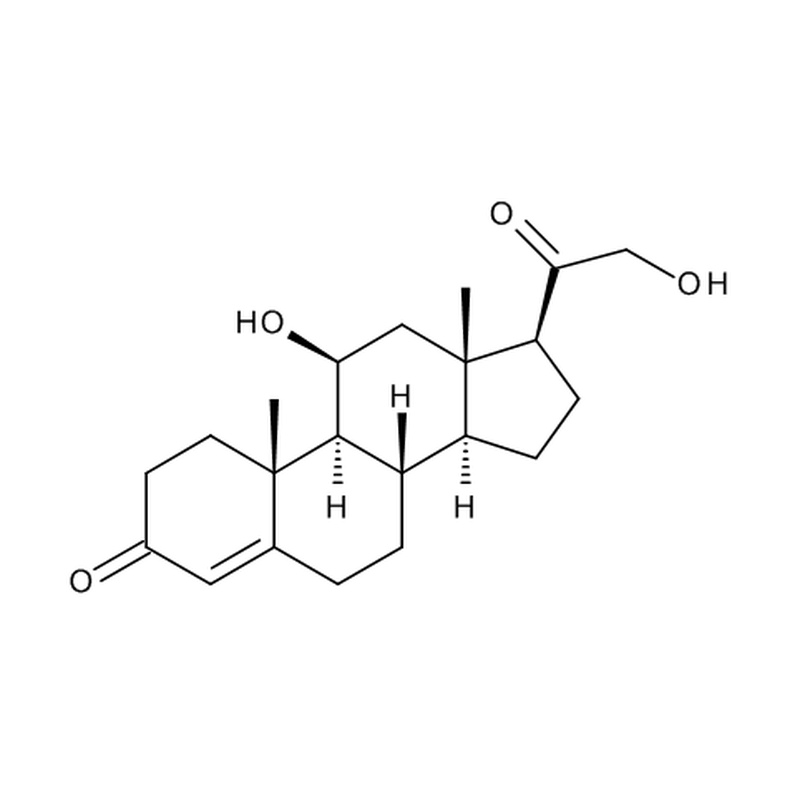产品
编 号:F370855
分子式:C21H30O4
分子量:346.46
分子式:C21H30O4
分子量:346.46
产品类型
规格
价格
是否有货
10mM*1mL in DMSO
询价
询价
50mg
528
In-stock
100mg
800
In-stock
结构图

CAS No: 50-22-6
产品详情
生物活性:
Corticosterone (17-Deoxycortisol) is an orally active and adrenal cortex-produced glucocorticoid, which plays an important role in regulating neuronal functions of the limbic system (including hippocampus, prefrontal cortex, and amygdala). Corticosterone increases the Rab-mediated AMPAR membrane traffic via SGK-induced phosphorylation of GDI. Corticosterone also interferes with the maturation of dendritic cells and shows a good immunosuppressive effect.
体内研究:
Corticosterone results in a marked reduction in the ability of BMDC cells to prime naive CD8+ T cells in vivo.Corticosterone (0.03 or 1 mg/kg; s.c.; single) downregulates expression of BDNF mRNA in dentate gyrus and CA1 of rats.Corticosterone (2.6 mg/kg; in animal feedings; 8 days) restores ethanol intake and preference to approximately normal preoperative levels in adrenalectomy (ADX) rats.Animal Model:Adult male Wistar rats (150-170 g; adrenalectomized).
Dosage:0.03 or 1 mg/kg
Administration:Subcutaneous injection; single.
Result:Decreased expression of BDNF mRNA in dentate gyrus, with 25% and 50% lower for dosages of 0.03 and 1 mg/kg, respectively (3 h after administration).Reduced approximately 40% BDNF mRNA level as compared to the t=0 h control group (3 h after administration), but the level increased by 100% when 12 h after administration (compared to t=3 h and t=6 h group).
Animal Model:Male Wistar rats (3-week-old; adrenalectomized).
Dosage:2.6 mg/kg
Administration:In animal feedings; 8 days.
Result:Restored ethanol intake and preference of adrenalectomy (ADX) rats to approximately normal preoperative levels and to the levels observed in the sham-operated group (SH) rats.
体外研究:
Corticosterone (100 nM; 30 min) via SGK phosphorylation of GDI at Ser-213, increases the formation of GDI-Rab4 complex, facilitating the functional cycle of Rab4 and Rab4-mediated recycling of AMPARs to the synaptic membrane.Corticosterone (CORT) (1 μM; 48 h) shows good immunosuppressive properties (functionally compromises maturation of BMDC), which impairs LPS-induced up-regulation of maturation-associated markers (MHC class II, B7.2, B7.1 and CD40).
Corticosterone (17-Deoxycortisol) is an orally active and adrenal cortex-produced glucocorticoid, which plays an important role in regulating neuronal functions of the limbic system (including hippocampus, prefrontal cortex, and amygdala). Corticosterone increases the Rab-mediated AMPAR membrane traffic via SGK-induced phosphorylation of GDI. Corticosterone also interferes with the maturation of dendritic cells and shows a good immunosuppressive effect.
体内研究:
Corticosterone results in a marked reduction in the ability of BMDC cells to prime naive CD8+ T cells in vivo.Corticosterone (0.03 or 1 mg/kg; s.c.; single) downregulates expression of BDNF mRNA in dentate gyrus and CA1 of rats.Corticosterone (2.6 mg/kg; in animal feedings; 8 days) restores ethanol intake and preference to approximately normal preoperative levels in adrenalectomy (ADX) rats.Animal Model:Adult male Wistar rats (150-170 g; adrenalectomized).
Dosage:0.03 or 1 mg/kg
Administration:Subcutaneous injection; single.
Result:Decreased expression of BDNF mRNA in dentate gyrus, with 25% and 50% lower for dosages of 0.03 and 1 mg/kg, respectively (3 h after administration).Reduced approximately 40% BDNF mRNA level as compared to the t=0 h control group (3 h after administration), but the level increased by 100% when 12 h after administration (compared to t=3 h and t=6 h group).
Animal Model:Male Wistar rats (3-week-old; adrenalectomized).
Dosage:2.6 mg/kg
Administration:In animal feedings; 8 days.
Result:Restored ethanol intake and preference of adrenalectomy (ADX) rats to approximately normal preoperative levels and to the levels observed in the sham-operated group (SH) rats.
体外研究:
Corticosterone (100 nM; 30 min) via SGK phosphorylation of GDI at Ser-213, increases the formation of GDI-Rab4 complex, facilitating the functional cycle of Rab4 and Rab4-mediated recycling of AMPARs to the synaptic membrane.Corticosterone (CORT) (1 μM; 48 h) shows good immunosuppressive properties (functionally compromises maturation of BMDC), which impairs LPS-induced up-regulation of maturation-associated markers (MHC class II, B7.2, B7.1 and CD40).
产品资料

